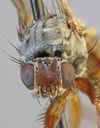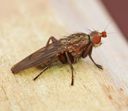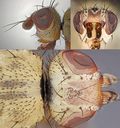Sphaeroceroidea
Sphaeroceroidea
Classification
- Phylum: Arthropoda
- Subphylum: Hexapoda
- Class: Insecta
- Order: Diptera
- Superfamily: Sphaeroceroidea
Pronunciation
How to pronounce Sphaeroceroidea: /sfɛroʊˈsɛrɔɪdiə/
These audio files are automatically generated. While they are not always 100% accurate, they are a good starting point.
Images






Summary
Sphaeroceroidea is a diverse superfamily of flies that includes numerous small species associated with decaying organic materials. Its taxonomy has experienced disputes, but recent studies affirm its monophyletic nature.
Physical Characteristics
Sphaeroceroids are small flies, generally a few millimeters in length. Families within Sphaeroceroidea have distinct traits: Sphaeroceridae exhibit black wings with an interrupted costa and have a short, thick first tarsomere on the hind leg. Nannodastiidae are particularly small, with adults measuring 0.70-1.25 mm long and lacking long setae on their legs.
Identification Tips
Identifying Sphaeroceroidea involves observing wing characteristics and body size. Sphaeroceridae can be recognized by their specific wing shape and tarsomere structure.
Habitat
Sphaeroceroid larvae thrive in decaying organic matter, such as manure, seaweed, fungi, rotting wood, compost, and carrion. Nannodastiidae are typically found in tropical and subtropical beaches, often in caves or under cliff overhangs.
Distribution
Sphaeroceroidea is cosmopolitan, with about 2,600 species found worldwide.
Diet
The larvae of Sphaeroceroidea generally feed on decaying organic matter, including various types of manure and carrion.
Life Cycle
Life cycle details for Sphaeroceroidea are not extensively outlined, but larvae are known to inhabit decaying organic matter.
Ecosystem Role
Sphaeroceroidea play a role in decomposition and nutrient cycling by feeding on decaying organic materials.
Evolution
Sphaeroceroidea are confirmed to be monophyletic, and phylogenetic studies indicate they are the sister group to all other Schizophora.
Similar Taxa
- Sphaeroceridae
- Heleomyzidae
- Chyromyidae
- Nannodastiidae
Misconceptions
Some may confuse Sphaeroceroidea with other fly families due to their similar small size, but distinguishing traits can be identified with close observation.
Tags
- flies
- Sphaeroceroidea
- ecology
- taxonomy
- insects